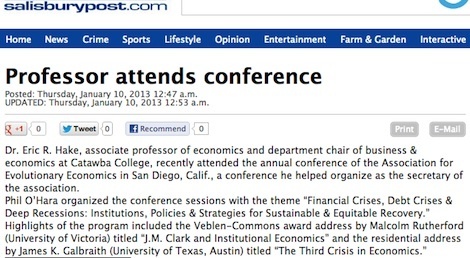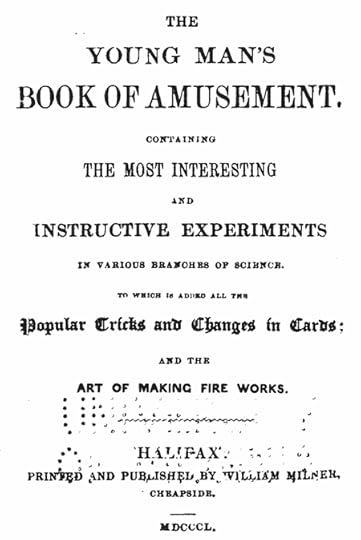Marc Abrahams's Blog, page 522
January 11, 2013
Frogs: Trash exits via the bladder
New research about things that get under frogs’s skin, and what can happen to those things:
“Removing the rubbish: frogs eliminate foreign objects from the body cavity through the bladder,” Christopher R. Tracy, Keith A. Christian, Lorrae J. McArthur and C. M. Gienger, Biology Letters. published online 2010. (Thanks to investigator Barry Pinshow for bringing this to our attention.) The authors, at Charles Darwin University, Darwin, NT, Australia, report:
“These observations led us to hypothesize that frogs may have a unique mechanism for eliminating foreign objects from the peritoneal cavity: they are moved into the bladder and then expelled during urination….
“This ability, as well as trans-intestinal expulsion, could lead researchers to draw misleading conclusions about mortality of telemetered individuals assumed to disappear owing to predation. Such incorrect conclusions could be dangerous by leading to inaccurate estimates of population dynamics for population viability models of endangered species.”

A Drink Can Be Too Cool: The Lethal Liquid Nitrogen Cocktail
Cocktails can be ultra-chilling. This medical report provides evidence to that effect:
“A lethal cocktail: gastric perforation following liquid nitrogen ingestion,” James Scott Pollard, Joanne Elizabeth Simpson, Moatasiem Idris Bukhari, BMJ Case Reports, 2013;10.1136/bcr-2012-007769. The authors, at the Royal Lancaster Infirmary [pictured below], Lancaster, UK, write:
“We report a case of gastric perforation in an 18-year-old girl as a result of ingesting an alcoholic drink containing liquid nitrogen. The drink was purchased in licensed premises. The extent of the injury necessitated total gastrectomy with Roux-en Y reconstruction…. The authors believe this case is of educational interest to professionals working in emergency medicine, general surgery and public health fields. It raises awareness of a rare injury, but one that may be more commonly encountered because of developing social trends. It informs surgeons confronted with this type of injury that trauma to the gastrointestinal tract can be extensive and preoperative contact with oesophago-gastric colleagues is advisable. Public health bodies must be aware of, and monitor, the use of liquid nitrogen in this way and consider regulation to prevent further injuries.”
BONUS: ”Liquid Nitrogen Cocktails: Smoking Hot Trend Or Unnecessary Risk?” [NPR]

January 10, 2013
CONCEPTS: FISH | BANANAS
 Philosophers are sometimes faced with tackling the complex issues of ‘concepts’. Over the years, as an aid towards a better grasp of ‘concepts’, various standard examples have been developed.
Philosophers are sometimes faced with tackling the complex issues of ‘concepts’. Over the years, as an aid towards a better grasp of ‘concepts’, various standard examples have been developed.
Take, for instance, PET FISH and MONSTER BANANAS (Note: the use of SMALL CAPS is traditional in the philosophical literature when dealing with CONCEPTS).
Although their occurrence together in the philosophical literature is fairly rare, there are examples. See for instance the PhD thesis of Dr. Jussi Jylkkä, (a postdoc researcher at the University of Turku, Finland). His thesis, entitled Concepts and Reference. Defending a Dual Theory of Natural Kind Concepts (published in Reports from the Department of Philosophy, vol. 21. Turku, Finland: Painosalama.) explains :
“…in forming the concept PET FISH, the concept PET affects feature dimensions of FISH , such as size and cuteness, but leaves the coat dimension intact.”
and :
“I suppose that it is theoretically possible that a speaker could possess a complex concept like MONSTER BANANA simply in virtue of possessing its constituent prototypes MONSTER , and BANANA (and grasping some basic logic), without forming a representation of it at all: the complex concept would refer to whatever triggers both the prototypes MONSTER and BANANA (in the actual world, of course, a speaker can easily imagine what kind of an object a monster banana might be). “
NOTES:
[1] The PET FISH example was first developed in 1981 in the paper by Osherson, D. N., & Smith, E. E. On the adequacy of prototype theory as a theory of concepts. (Cognition, 9, 35 – 58.)
[2] The origins of the MONSTER BANANA CONCEPT are less easily traced (readers’ assistance gratefully accepted.)
[3] Dr. Jylkkä not only studies CONCEPTS, he also plays THE BLUES.

Magazine: the special Ig Nobel issue
 The special Ig Nobel issue (vol. 18, no. 6) of the magazine (the Annals of Improbable Research) is now out!
The special Ig Nobel issue (vol. 18, no. 6) of the magazine (the Annals of Improbable Research) is now out!
It’s got lots and lots and lots of detail (especially pictures) about the 23rd First Annual Ig Nobel Prize ceremony: the winners, the acceptance speeches, the 24/7 Lectures, the full libretto to the new opera, and more, more, more.
Mel (right) says it’s swell.
Click on the Mel’s face to see the table of contents, buy the e-book version, or subscribe to the paper version.

Honestly, overly, methodically, with tweets and occasional venom
Scientists are dropping their euphemisms, in a discussion about #overlyhonestmethods. The discussion is happening in that den of conversation and twaddle called “twitter”. These are translations into blunt words about how some people conduct their experiments.
A parallel discussion concerns #overlyhonestreviews. These are translations into blunt words about how some people go about reviewing the work of their peers. Think of it as a peer into the depths of peer review.
BONUS: io9 has a discussion of this, with a selection of some of their favorite tweets.

TED Talks to feature two Ig Nobel Prize veterans
Two Ig Nobel Prize celebrities are in the lineup for the 2013 TED talks, which was announced today:
Kees Moeliker , who was awarded the 2003 Ig Nobel Prize winner in biology for documenting the first scientifically recorded case of homosexual necrophilia in the mallard duck.
Amanda Palmer , who performed as a singer (and once as a wedding prop) in several Ig Nobel Prize ceremonies.
Both are known for doing other things, too (and both have helped organize several Ig Nobel Prize ceremonies). Here are video glimpses of a mere single aspect of each of them:
The TED Talks will run from February 25 to March 1, in Long Beach and Palm Beach, California.
BONUS: Ig Nobel Prize winner Dan Ariely’s TED talk a few years ago.
BONUS: Ig Nobel Prize winner Philip Zimbardo’s TED talk a few years ago.
BONUS: Ig Nobel Prize winner Frans de Waal’s TED talk a few years ago.
BONUS: Ig Nobel Prize winner Bart Knols’s TED talk (in Maastricht) a few years ago
BONUS: Kees Moeliker writes about some of the adventures on the road to being invited to do a TED talk.

Today’s News: Professor attends conference
The Salisbury Post, in North Carolina, reports:
Professor attends conference
Posted: Thursday, January 10, 2013 12:47 a.m.
UPDATED: Thursday, January 10, 2013 12:53 a.m.
Dr. Eric R. Hake, associate professor of economics and department chair of business & economics at Catawba College, recently attended the annual conference of the Association for Evolutionary Economics in San Diego, Calif., a conference he helped organize as the secretary of the association….
(via Eric Lach at TPM)
We intend to carry follow-up news if and as necessary.
BONUS: Professor Hake’s resume
BONUS: Professor Hake in the news

January 9, 2013
Old amusements book for new men
If you are a young man inclined to read old books about amusement for men who were, at the time the books were written, young, this book may provide some amusement. Called The Young Man’s Book of Amusement, it was published in 1856, and is now online thanks to Google Books:

About-Face on Face Shape?
A new study about faces implies than an old study about faces (which we wrote about way back when) should not be taken at face value:
“Lack of Support for the Association between Facial Shape and Aggression: A Reappraisal Based on a Worldwide Population Genetics Perspective,” Jorge Gómez-Valdés, Tábita Hünemeier, Mirsha Quinto-Sánchez, Carolina Paschetta, Soledad de Azevedo, Marina F. González, Neus Martínez-Abadías, Mireia Esparza, Héctor M. Pucciarelli, Francisco M. Salzano, Claiton H. D. Bau, Maria Cátira Bortolini, Rolando González-José, PLoS ONE 8(1), January 9, 2013, e52317. (Thanks to Ig Nobel Prize winner Geoffrey Miller for bringing this to our attention.) The authors explain:
“A recent study proposed that men with wider faces relative to facial height (fWHR) are more likely to develop unethical behaviour mediated by a psychological sense of power…. Here we show that 4,960 individuals from 94 modern human populations belonging to a vast array of genetic and cultural contexts do not display significant amounts of fWHR sexual dimorphism. Further analyses using populations with associated ethnographical records as well as samples of male prisoners of the Mexico City Federal Penitentiary condemned by crimes of variable level of inter-personal aggression (homicide, robbery, and minor faults) did not show significant evidence…. Overall, our results suggest that facial attributes are poor predictors of aggressive behaviour.”

Special topics, special journal
Maggie Koerth-Baker writes (in BoingBoing) about The Journal of Physics Special Topics (which we have admired now and again):
What’s the point of all this? That’s the really interesting part.
You’re right in thinking that the plausibility of fictional scenarios isn’t exactly a great problem of our time. But nobody ever said it was. That wasn’t the point of this paper, or any of the other eight papers Watkinson, Staab, Walach, and Rogerson published last year.
Instead, this was about teaching them how to be better scientists.
The Journal of Physics Special Topics is, itself, a pretty special journal. It’s written, edited, peer reviewed, and published by students of physics professor Mervyn Roy. Throughout the course of a semester, teams of students come up with problems they can use physics to solve. They get a week to research and write each two-page paper. Then they hand those papers off to their peers, who put them through a rigorous peer review process — critiquing the physics, demanding edits in grammar and style, and sending the students back over and over until they’ve polished up something that is worthy of publication.
It’s a microcosm of the way academic publishing is done in the real world and it gives the students a chance to learn through trial and error both how to write a paper AND how to peer review one….

Marc Abrahams's Blog
- Marc Abrahams's profile
- 14 followers






